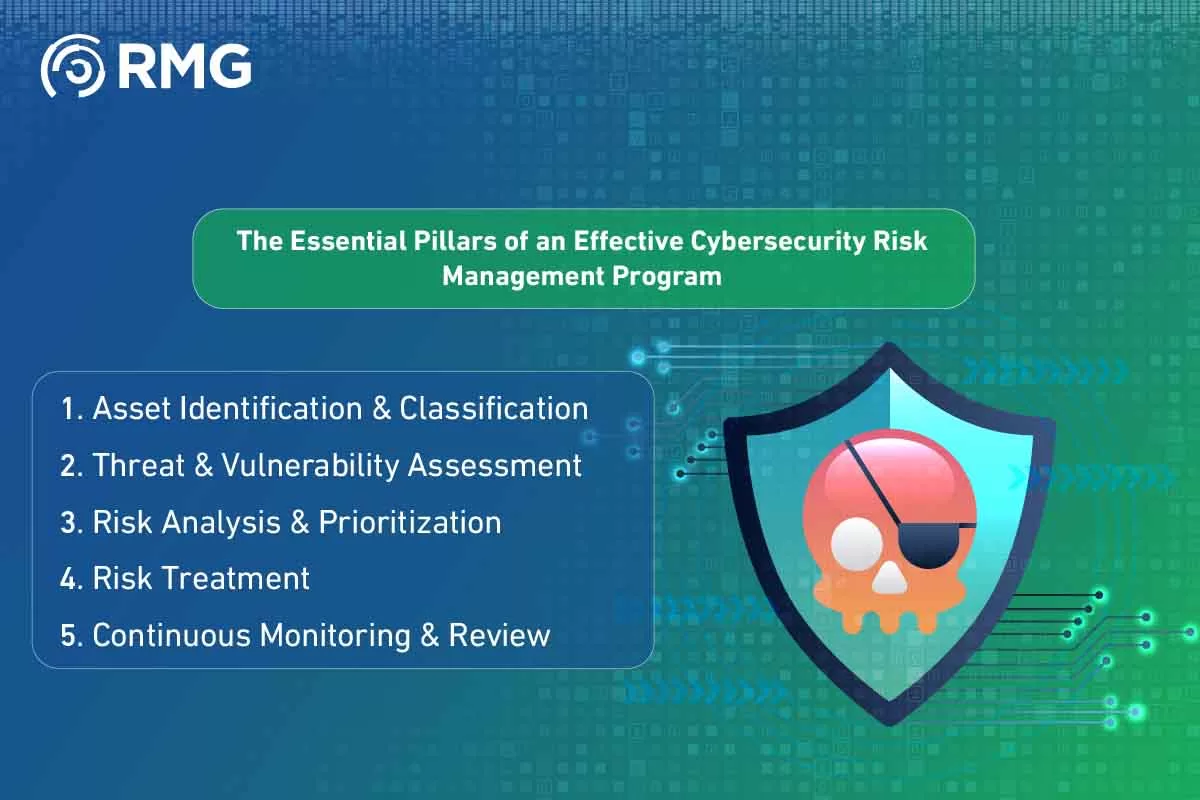Blog Body
Discover how Cybersecurity Risk Management can be your first line of defense. Learn strategies to protect digital assets, comply with National Cybersecurity Authority standards, and secure your business continuity in the Kingdom. Fortify your organization’s future now.
Why is Cybersecurity Risk Management the Cornerstone of Any Successful Organization?
In the era of rapid digital transformation witnessed in Saudi Arabia, cyberattacks are no longer distant possibilities; they’ve become a reality threatening the stability of public and private organizations alike. Here, cybersecurity risk management emerges not as a secondary technical measure, but as a pivotal strategic practice at the heart of corporate governance and business continuity. It’s the structured methodology that enables organizations to shift from a reactive defense to a proactive offense, by identifying, assessing, and addressing potential threats before they escalate into costly disasters. In a business environment increasingly reliant on data and digital assets, the ability to effectively manage cyber risks becomes the differentiator between secure growth and sudden disruption.
The Essential Pillars of an Effective Cybersecurity Risk Management Program
Building a mature and effective cybersecurity risk management program isn’t random; it relies on a systematic and integrated framework that goes through several vital stages, ensuring comprehensive coverage and robust defenses. These pillars form a continuous lifecycle, guaranteeing flexibility and adaptability to the evolving threat landscape.
- Asset Identification & Classification: The first and most critical step is knowing what you aim to protect. You can’t protect an asset you don’t know exists. This stage involves inventorying all of the organization’s digital and information assets – from servers and data to systems, applications, and networks – then classifying them based on their importance and sensitivity to the organization’s operations. This classification helps direct security resources toward the most valuable and critical assets.
- Threat & Vulnerability Assessment: After identifying assets, the next stage is understanding the risks surrounding them. This is done by identifying potential threat sources (such as hackers, malware, human error) and evaluating existing security vulnerabilities in systems and infrastructure. This assessment provides a clear view of weaknesses that attackers might exploit.
- Risk Analysis & Prioritization: In this stage, assets, threats, and vulnerabilities are linked to determine the actual risk level. Each risk is analyzed based on two key factors: its likelihood of occurrence and its impact if it does occur. Based on this analysis, risks are prioritized, allowing the organization to focus on addressing the highest-impact risks first.
- Risk Treatment: After identifying and prioritizing risks, a decision must be made on how to deal with them. There are four main strategies for risk treatment:
- Mitigate: Apply security controls to reduce the likelihood or impact of the risk.
- Accept: Accept the risk when the cost of addressing it outweighs its potential impact.
- Transfer: Transfer the risk to a third party, such as by purchasing a cyber insurance policy.
- Avoid: Stop the activity causing the risk entirely.
- Continuous Monitoring & Review: Cybersecurity risk management isn’t a project that ends; it’s an ongoing process. Security controls must be continuously monitored to ensure their effectiveness, and risks periodically re-evaluated to keep pace with new threats or changes in the operating environment.
Cybersecurity Risk Management as a Strategic Requirement in the Saudi Business Environment
In line with the tremendous developments in digital infrastructure, Saudi Arabia has established strict regulatory frameworks to ensure the protection of its cyberspace. The National Cybersecurity Authority (NCA) stands at the forefront of these efforts, having issued the “Essential Cybersecurity Controls (ECC)” which oblige all government and private entities that own or operate critical infrastructure to implement them. Adopting a structured approach to cybersecurity risk management is no longer an option; it’s a fundamental requirement for complying with these regulations and avoiding penalties. Furthermore, this practice enhances trust among investors, customers, and partners, confirming that the organization takes its responsibility seriously in protecting data and maintaining the continuity of its vital services.
What are the Direct Benefits of Implementing an Integrated Cyber Risk Management Framework?
Investing in building strong cybersecurity risk management capabilities provides organizations with strategic and operational benefits that go beyond mere technical protection. Among the most prominent benefits are:
- Informed Decision-Making: Provides clear visibility into risks, helping senior management make better decisions about security investments and resource allocation.
- Improved Security ROI: By focusing efforts and budgets on addressing the most critical risks, the organization avoids unnecessary spending on ineffective security solutions.
- Enhanced Regulatory Compliance: Systematic implementation of risk management ensures compliance with the requirements of the National Cybersecurity Authority and other regulatory bodies like the Saudi Central Bank (SAMA).
- Increased Operational Resilience: By understanding the potential impact of risks, the organization can develop incident response and business continuity plans that ensure rapid recovery from any cyberattack.
- Building a Trusted Reputation: An organization that demonstrates a strong commitment to cybersecurity gains the trust of its customers and partners, giving it a strong competitive advantage in the market.
Common Challenges in Implementing Cybersecurity Risk Management and How to Overcome Them
Despite its paramount importance, many organizations face challenges when attempting to implement cybersecurity risk management programs. Among the most prominent challenges are:
- Complexity of the Cyber Landscape: The continuous evolution of threats makes it difficult to keep pace.
- Lack of Specialized Competencies: A skills gap in effectively assessing and managing cyber risks.
- Difficulty Gaining Management Support: Senior management may not realize the strategic importance of investing in cybersecurity until an incident occurs.
- Resistance to Change Within the Organization: Employees may resist implementing new security policies and controls.
Overcoming these challenges lies in building a strong security culture within the organization, providing continuous training, leveraging specialized external expertise to bridge the skills gap and provide objective insights, and translating technical risks into understandable business language for senior management to illustrate the potential financial and operational impact.
Renad Al Majd: Your Strategic Partner in Building an Integrated Cybersecurity Risk Management System
In light of these challenges and requirements, the need for a trusted partner with deep expertise and a precise understanding of the business environment and regulations in the Kingdom becomes clear. Renad Al Majd (RMG) is not just a solution provider; it’s your strategic partner that empowers you to build and implement a comprehensive and effective cybersecurity risk management system. We help you transform this complex challenge into a competitive advantage by providing specialized consulting services that start from current state assessment, through designing a customized risk management framework aligned with your business nature and NCA requirements, all the way to assisting in implementing and continuously monitoring necessary controls.
Why Choose Renad Al Majd to Strengthen Your Cyber Defenses? Towards a Secure and Trusted Digital Future
Choosing the right partner on your digital fortification journey is a strategic decision that determines your organization’s future. What distinguishes Renad Al Majd is our commitment to delivering real value that goes beyond off-the-shelf technical solutions. We are characterized by:
- Deep Understanding of the Saudi Market: Our extensive experience working with government entities and the private sector gives us a precise understanding of local challenges, opportunities, and regulatory requirements.
- Team of Certified Experts: Our team includes a selection of consultants and experts holding the highest international certifications in cybersecurity and risk management.
- Customized Methodology: We believe that no single solution fits all. Therefore, we work hand-in-hand with our clients to develop customized strategies and solutions that meet their specific objectives.
- Focus on Results: Our goal is not just to implement controls but to ensure tangible results in terms of risk reduction, enhanced compliance, and confidently securing your business continuity.
Don’t wait until a risk occurs. Be proactive in protecting your digital assets and ensuring your business’s future. Contact our team of experts at Renad Al Majd today for a specialized consultation, and let us help you build your robust digital shield by implementing the best practices in cybersecurity risk management.
















